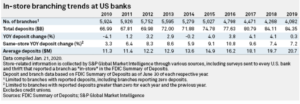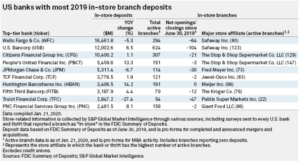S&P: US banks relying less on big-box stores to house branch locations
The growth of mobile and digital banking is driving in-store branch numbers down. In-store branches are satellite bank branches located inside large retail spaces, such as supermarkets or chains like Walmart and Safeway.
As of January, there were 3,989 in-store branches of FDIC-insured institutions housed within retail stores, a decrease of 2.3% since June 30, 2019, and 6.5% since June 30, 2018, S&P Global Market Intelligence reported.
Despite this dropping number of in-store branches, annual deposits for same-store branches had increased 7.2%. In-store deposits were at $84 billion as of June 2019, which was only a .3% increase during that time period, down from a 4.1% in 2018. This is in keeping with recent moves among banks that want to transform retail branches into centers for client consultation and customer acquisition.

The in–store branches are being shut down by regional and large banks. To gather information for the study, S&P Global Market Intelligence collected 2019 deposit data from the FDIC and conducted a survey of every bank in the U.S. that reported having an in-store branch.
Robert Clark, an author of the S&P report, said that there is a correlation between the growth in overall deposits despite in-store branch closures and digital investments.
“The number of branches has gone down for several years now, in large part that’s because banks are investing so heavily in digital channels,” Clark explained. “[Many banks] built too many branches in the past and now they’re right–sizing the network.”
One outlier is Woodforest Financial Group, which was ranked first for in-store branch openings and 11th for in-store deposits. Since June 30, 2018, Woodforest has added 48 branches, bringing its in-store network to 736, reported S&P Market Global Intelligence. Clark pointed out that, compared with banks shutting down in-store branches, most deposits made at Woodforest Financial Group branches were small.
See also:Big banks feel pressure to compete with digital lenders: S&P
According to the report, some large banks have seen a decrease in their in-store deposits following the closure of in-store branches since the profitabilty of those branches are expect to decrease in the future. Safeway, which is a major in-store affiliate by total deposits, houses the most branches for Wells Fargo and U.S. Bancorp.

During the year ended June 30, 2019, total deposits at branches in Safeway stores decreased 4.0% to $8.68 billion. Since June 2018, 62 in-store bank branches have closed at Safeway stores, mostly by U.S. Bancorp, Truist Financial Corp. and Wells Fargo. Clark said that by closing in-store branches, large banks are consolidating their footprints.
“Most of the major in-store branch [owning] banks are larger companies, and larger [banks] are the ones investing more in digital channels for customers,” Clark said.
He predicted that banks will continue to draw in customers via digital channels, and more banking customers will complete and keep tabs of their transactions via mobile and digital platforms like banking apps.
“[Closing branches] frees up capitals for the banks to invest more in digital channels,” Clark said.
Banking Automation Summit, which takes place from June 1-2 in Miami, is a unique opportunity to share insights, trends, strategies and best practices on back-office automation in financial services with the industry’s leading practitioners. Register here.















